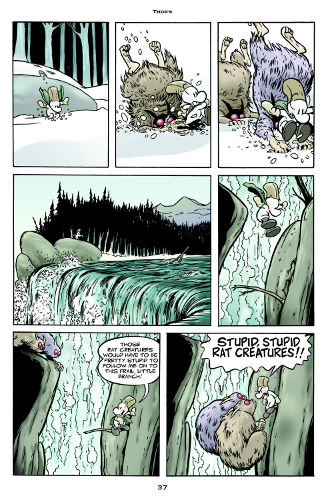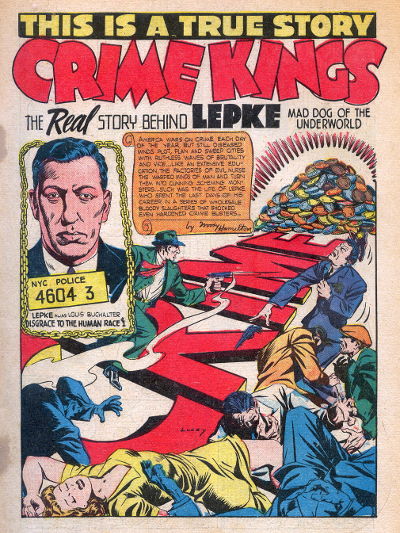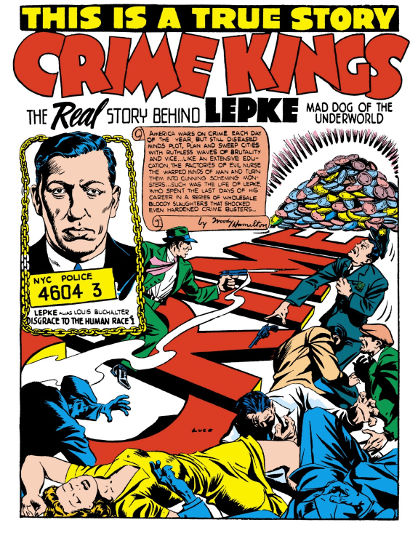Modified from a post on Brontoforumus, 2015-09-23.
In honor of Banned Books Week, the latest Humble Books Bundle is made up of banned and challenged comic books.
It's not just a good theme, it is, in terms of quality content for your money, the single best collection of comics I have ever seen. I've got a couple caveats about the presentation, which I'll get to in a minute, but it's well worth the price of admission, whatever tier you choose to donate at.
Pay more than the average and you get Heartbreak Soup.
Heartbreak Soup is my all-time favorite comic. Your mileage may vary, but as far as I'm concerned, the list of Greatest Comics of All Time goes Heartbreak Soup, then Maus, then that Spider-Man arc where he has to lift the rubble off him as Doc Ock's underwater base collapses. (No, Watchmen is not in my top three.)
The bundle also has the first volume of Bone. Bone is phenomenal; it's an all-ages adventure story in the classic mold, with influences from Walt Kelly to Carl Barks to Don Martin; it's funny and it's gorgeously drawn. You should definitely get it if you haven't read it yet; it's at the first tier so it can be yours for a penny.
The bottom tier's also got Maggie the Mechanic, which is the other Love and Rockets vol 1. (Heartbreak Soup is the first volume of Gilbert Hernandez's Palomar stories; Maggie the Mechanic is the first volume of Jaime Hernandez's Locas stories.) Maggie the Mechanic is great too, but for my money it's not as great as Heartbreak Soup, or as the other Locas stories that followed. (The Death of Speedy is widely regarded as the best Love and Rockets story; it's in vol 2 of Locas, which is not included in this bundle.)
Bottom tier also has The Frank Book. Jim Woodring's work is beautiful, surreal, wordless, and incredibly detailed. I have six pieces of comic book art hanging on my walls. One is a Quantum and Woody poster signed by Christopher Priest; one is an Uncle Scrooge print signed by Don Rosa. The other four are Jim Woodring prints that my uncle gave me for my birthday after using them in a museum exhibit.
There's some other stuff in there that I don't know as much about. I like Chester Brown but I haven't read The Little Man; I like Jeff Lemire but I haven't read Essex County. I suppose they're probably both pretty great based on their respective cartoonists' other work, but I don't know them.
And The Boys is in there. The Boys is not for me; I'm not a Garth Ennis fan. But if you like the sound of a bunch of asshole superheroes being taken down by a group of regular guys led by somebody who looks exactly like Simon Pegg, you'll probably dig it.
To summarize: it's a great bundle. It's worth buying for Heartbreak Soup, Bone, and Frank alone; I bought it mostly because I'd been wanting to pick up Frank, Essex County, and Information Doesn't Want to be Free by Cory Doctorow (available as an audiobook in this bundle; the only item that isn't a comic book).
So. Great bundle. But. As I said, there are some caveats with the format.
The first of which is, you're probably going to be reading these on a tablet. And some of these comics just don't look as good on a 10" screen.
I was especially worried about The Frank Book given the detail of Woodring's work; this stuff's meant to be read at 8.5"x11" size. But I was surprised to find it actually looks great on my tablet. The full-size book would be better, but it also costs $35 and weighs 3 pounds. And that's the paperback version.
Bone looks fantastic on my screen too.
Surprisingly, of the books I've thumbed through, the one that suffered most was Heartbreak Soup.
Part of that's to do with the ratio. The pages of Love and Rockets are shorter and wider than standard comic book pages.
-

Bone
Scaled to 325x500 -

Heartbreak Soup
Scaled to 405x500
So on a 6:10 screen like my tablet's, you're left with some major letterboxing and a picture that is uncomfortably small and looks a little jaggy, and text that can be hard to read. (If, on the other hand, you have a tablet with a 4:3 screen, like an iPad, I imagine the Love and Rockets -- and the other more square-ish comics in the collection -- will look a lot better, and you'll have the opposite problem with the more traditionally-sized comics in the set.)
Perfect Viewer also seemed to choke on the file a bit; after the first few pages, it started pausing for long periods of time on each page turn. At first I thought it was due to the file size (the CBZ version is 675MB), but The Frank Book is even bigger and Perfect Viewer didn't give me any trouble with it. So I don't know why it doesn't like Heartbreak Soup, but it doesn't.
In short, Heartbreak Soup is my favorite comic, but my 10" tablet is most definitely not the best way to read it. Again, your mileage may vary; you may have better luck on an iPad, as noted, or if you're cool with just reading it on a desktop computer monitor, it looks great on my 27" 2560x1440 screen. But if you're looking for comics to read on a widescreen tablet, well, there are still a lot of great books in this set that totally justify the purchase, but don't buy it just for Heartbreak Soup. All that said, though? It's still a great damn comic, it doesn't look that bad on my tablet, and if you don't want to look for it at your local library or pay full price for the paperback version, well, it's still worth a read.
There's another one I looked through that I have a visual complaint about, and unfortunately, it's an important one and the granddaddy of all challenged comics: Crime Does Not Pay.
Crime Does Not Pay is a classic. It's the first and most successful of the 1940's-'50's-era crime comics that led to Senate hearings and, eventually, the Comics Code and most of the industry going out of business. But, aside from simply being popular, controversial, and lurid, it's just plain good, with superlative work from the likes of Charles Biro, Bob Montana, and George Tuska.
It's also public domain. You can find most of the series for free on Digital Comic Museum (though if you can spare a donation to keep the site up and running, that would be swell too).
Given that, it's damned disappointing that Dark Horse did such a shoddy job on the colors.
-

Digital Comic Museum -

Dark Horse
The first image is a scan from one of the original 1950's printings of the comic. It's not pristine; the colors bleed, and if you look closely you can see right through the page to the panel grid from the opposite side. And there are marks on the left side of the page where the staples were.
But despite those flaws, it looks better than the second image, from Dark Horse's restoration. The colors in Dark Horse's version look garish.
And it's down to the paper stock. The scan looks the way it's supposed to, because those colors are supposed to be printed on newsprint. The background is supposed to look a little gray or tan, and the colors are supposed to soak in and blend together.
Dark Horse's version looks garish because they kept the original four-color printing process but put it on high-quality, glossy paper (or the digital equivalent of same). The colors look wrong.
But, in Dark Horse's defense, it could have been worse -- at least they didn't re-color it. Have you seen what they've done to their Conan reprints? Photoshop gradients everywhere. The horror. The horror.
"It could have been worse" isn't a great defense, though. When it comes right down to it, I'd rather read the Digital Comic Museum version, even if I can see the grid lines from the other side of the page.
The only problem is, the Dark Horse collection contains issues #22-#25 (don't let the numbering fool you; #22 is the first issue -- in those days it was common, when a publisher canceled a comic and started a new one, for the new series to continue the old series' numbering with a new title), and Digital Comic Museum doesn't have #23-#25. So while you can download DCM's superior version of issue #22 (and #26, and #27, and lots more, on up through #147), if you want to read #23-25 then you're stuck with the Dark Horse version, and you'd better be prepared for a hell of a lot of eye-searing bright yellow.
There are plenty of instances of publishers doing reprints of old comics right -- either by using newsprint or by scanning or photographing the original printed pages -- but this isn't one of 'em, and that's a shame.
But, all that grousing aside, this bundle? If you have never read a comic book in your life, this has three that I would rank as Absolute Must-Read, in Heartbreak Soup, Bone, and Frank. It's got one of the legitimate most important comics of all time in Crime Does Not Pay, even if I've got some gripes about the presentation and you might be better off grabbing a scanned version from Digital Comic Museum. And aside from those, it's got several more that may not be quite so high on the must-read list but still rank as Great.
If you like good comics, you should get it. And if you don't like good comics, you should get it anyway, because maybe you just haven't ready any comics this good yet.
The bundle runs for five more days.